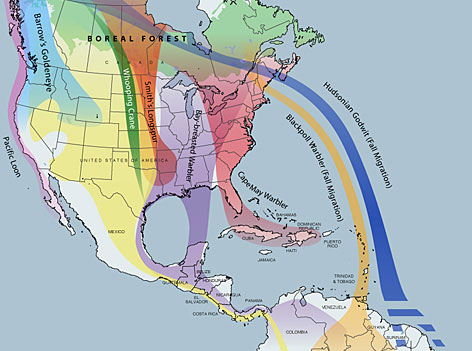Canada is home to millions of migrating birds that return to our lakes and forests each spring to nest and reproduce, before returning south in the fall. Approximately 327 bird species regularly occur in the Boreal Forest– that’s nearly 50% of the species found in the U.S. and Canada.
Why do they make this long, hazardous annual journey? The simple answer is abundance of food, and the timing of the breeding cycle.
At the end of each Ice Age, more and more land appeared in the north. At the height of summer, birds that moved into these areas would have found a bonanza of food, longer daylight hours to feed and increased breeding space.
But these birds would have also found that as winter approached, they had to retreat south. Present day migratory patterns have evolved over thousands of years of climatic change. Migrating birds use well established, food-rich paths along a north-south axis. The need to undertake this journey is now instinctive.
Birds return in early spring, often in miserable harsh weather. If birds waited until the food on their breeding range became abundant to begin the migration, they would not have time to migrate, mate, incubate and raise young to take advantage of the abundance of insects and other food species.
The timing of the cycle must result in the young having an abundance of food, as well as warmer weather, so they arrive early in the spring.
The reverse is also true for the fall migration. If they waited until the climate in the breeding range became intolerable, it would be too late to gain the necessary energy surplus requirements required to sustain a long migration.
How do they find their way?
This has puzzled people for centuries. We know they use a variety of tools, but full understanding of bird migration still eludes us.
Birds are thought to calculate the sun’s arc relative to the horizon, using its height and direction to obtain a north-south axis. Nocturnal migrants may use the stars to navigate. A known sensitivity to changes in barometric pressure enables them to avoid bad weather and exploit tail winds.
The ability to detect low frequency sound waves may help them hear things like breaking waves, while their own calls may be picked up as echos off mountains. Other factors such as the magnetic field of the earth, or the moon, may also be used.
While the facts of migration may elude us, the dangers of it do not.
- most songbirds migrate at night, when they may be struck by planes, autos or trains
- birds run into buildings, utility wires and high bridges
- cell phone towers, radio and TV towers, and the steel cables that support them kill an estimated one million birds each year
- wind turbine farms also take an enormous toll on migrating birds
- birds become disoriented by the dazzling lights of airports, lighthouses and floodlit buildings
It’s worth noting that these circumstances account for more deaths each year than all other causes of mortality combined – and they’re all man made.




Pingback: The Top Spring Season Activities For Seniors This 2021 - Care At Home Services
Likely Sandhill cranes, which are seen in their thousands in autumn migration in Alberta.
I observed very large flocks of large birds yesterday and today flying very high west of Edmonton. Could they have been whooping cranes. Their sound was not Canada Goose sounds.
They may have moved to an area with less smoke to make it easier for them to find food. I’m not sure how far they may have to go this year though.
Are skies are clouded by smoke from British Columbia. We’ve noticed that the sparrows, crows, and blue jays have all but gone. Is this from the smoke?
Pingback: Landscaping that Provides Rest Areas for Migrating Birds & Butterflies : Sustainable Landscape Design and Green Building